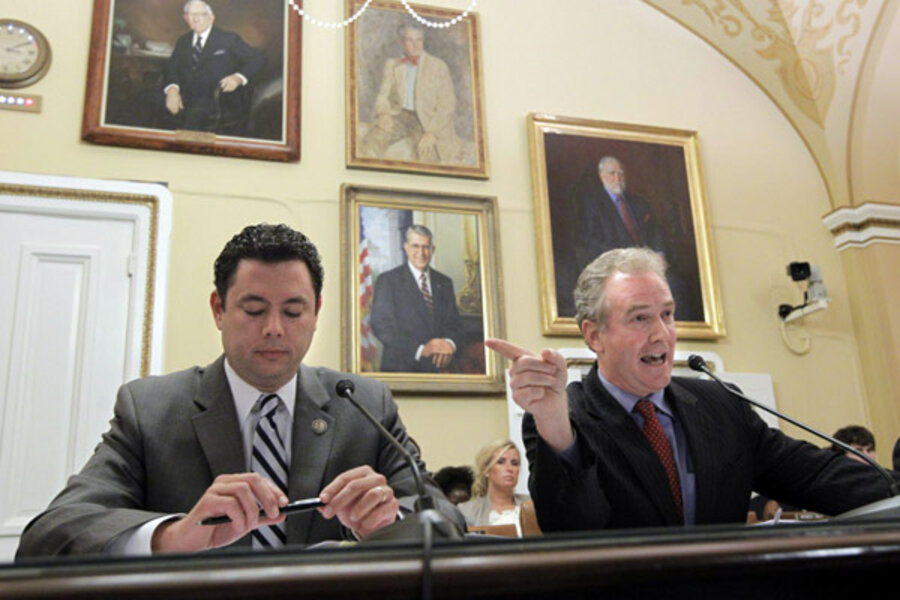'Cut, cap, and balance' vs. 'gang of six' plan: Which for House GOP?
Loading...
| Washington
Members of the House of Representatives gathered Tuesday to vote on their preferred option to resolving the national debt crisis – dubbed "cut, cap, and balance" – even as President Obama threw his support behind a new bipartisan deal crafted by a revived "gang of six" senators that includes a mix of spending cuts and new tax revenues.
Though the House vote is widely seen as symbolic – having little chance of being picked up in the Democratic-controlled Senate and facing a presidential veto even if, miraculously, it did – it is nonetheless important to Republican lawmakers. By virtue of the vote, slated for Tuesday evening, the House will go on record as having offered its own plan for resolution of the looming debt crisis. It will also give political cover to GOP members who want to show they voted for a plan that would force a fiscal overhaul along conservative lines.
Their pending vote, however, was eclipsed by Mr. Obama's announcement that the Senate's reborn "gang of six" negotiators had sent their "balanced" approach to solving the debt crisis to the White House. Their plan is said to call for whittling the deficit by $3.6 trillion over a decade or more – and includes adjustments to entitlement programs as well as elimination of tax loopholes and other revenue increases. Obama, in an apparent acknowledgment of the importance to GOP lawmakers of the vote on the "cut, cap, and balance" legislation, said he would contact Speaker John Boehner after the vote to schedule a meeting among congressional leaders and the White House about the "gang of six" proposal.
The House "cut, cap, and balance" measure would do the following:
• Cut US spending for the next fiscal year by $111 billion.
* Cap annual federal spending at less than 20 percent of the economy, as measured by the gross domestic product.
• Balance the budget each year via a constitutional amendment, called the Balanced Budget Amendment. The measure, if passed, would send the amendment to the states for ratification.
The White House opposes "cut, cap, and balance," saying it would “set unrealistic spending caps” and undermine the federal commitment to “seniors, middle-class families, and the most vulnerable.” The president has said he would veto it if it ever were to reach his desk.
Conservatives say only a Balanced Budget Amendment can bind a future Congress, ensuring that the nation doesn’t raise the debt ceiling this time and then go back to big-spending ways.
“Today is going to be a very big contrast in approach that Republicans and the president have taken when it comes to major issues,” said House majority whip Kevin McCarthy (R) of California at a press conference on Tuesday. “The message has never changed from this president. He just wants to spend more.”
Several forums for resolving the debt ceiling issue have come to the fore, in succession, in recent months. After the bipartisan Senate "gang of six" negotiations faltered in the spring, Vice President Joe Biden began a series of meetings with designated lawmakers. When those sessions stalled, Obama called meetings at the White House, also to no avail. Then, late last week, the "gang of six" resumed work, this time producing a possible deal that appears to have Obama's interest if not his support.
A proposal from Senate minority leader Mitch McConnell (R) of Kentucky, which Senator McConnell himself describes as a "last choice" option to prevent a US default, is also attracting a measure of bipartisan support. The plan, which requires implementing legislation to first pass the Congress, allows Obama to request a $2.5 trillion debt-limit increase that would automatically become law unless Congress passes a resolution of disapproval.
Senate majority leader Harry Reid is working with McConnell to enhance the measure to include a commission to propose longer-ranging plans to get the nation back on a sustainable fiscal footing. Many conservative lawmakers have opposed the plan in advance, because it deprives them of leverage on a Balanced Budget Amendment.





